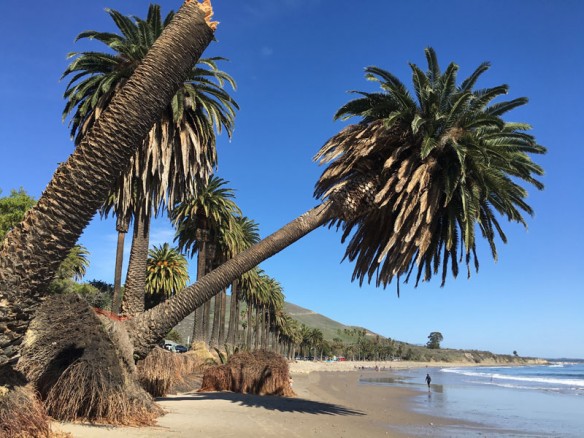
Severe coastal erosion, Refugio State Beach, California. Photo: © SAF – Coastal Care
Excerpts;
This is supposed to be a beautiful beach, but instead it looks like a disaster area because a sea wall built about a decade ago to protect homes has failed. Now property owners are spending millions to fix it.
From Mexico to Oregon, the iconic California coastline runs more than 3,400 miles. “CBS This Morning” correspondent Jonathan Vigliotti drove just over 600 of those miles to see how the state is getting ready for what scientists say is the inevitable future…
Read Full Article; CBS News (09-25-2019)
Sea Level Rise Could Double Erosion Rates of Southern California Coastal Cliffs; USGS (07-09-2018)
Coastal cliffs from Santa Barbara to San Diego might crumble at more than twice the historical rate by the year 2100 as sea levels rise. U.S. Geological Survey scientists combined several computer models for the first time to forecast cliff erosion along the Southern California coast…
Iconic Refugio Beach Palms May Soon Be History; Noozhawk (02-21-2016)
Disappearing Beaches: Modeling Shoreline Change in Southern California; USGS (02-14-2017)
Using a newly-developed computer model, scientists predict that with limited human intervention, 31 to 67 percent of Southern California beaches may become completely eroded (up to existing coastal infrastructure or sea-cliffs) by the year 2100 under scenarios of sea-level rise of one to two meters…
Beach Bashing; UCSB Current News (02-14-2017)
New research conducted by U.S. Geological Survey (USGS) scientists and their colleagues at UC Santa Barbara and six other institutions found that during the 2015-16 El Niño winter beach erosion on the Pacific coast was 76 percent above normal, and that most beaches in California eroded beyond historical extremes…
Worst erosion in 150 years tears 180 feet from SF’s Ocean Beach; SF Gate (02-15-2017)
The beaches lining the coast between Mexico and Canada form a protective barrier that keeps the turbulent ocean from eating away at seaside cliffs and flooding low-lying coastal towns and cities, scientists say…
Sea-Level Rise Poses Hard Choice for Two Neighborhoods: Rebuild or Retreat? Take Part (04-25-2015)
California Coastal Armoring Report: Managing Coastal Armoring and Climate Change Adaptation in the 21st Century;By Molly Loughney Melius, Fellow, Stanford Law School Margaret R. Caldwell, Diretor, Environment and Natural Resources Law & Policy Program, Stanford Law School (May 2015)
In response to erosion and storm events, Californians have built seawalls, revetments, and other “coastal armoring” structures along significant portions of California’s coast. Coastal armoring now occupies more than 110 miles, or at least 10 percent, of the overall California coastline. This coastal armoring has diminished California’s beaches and habitat, irreversibly altered bluffs, caused increased erosion to neighboring properties, and marred the natural beauty of the coast…
“Seawalls Kill Beaches,” Open Letters by Warner Chabot And Rob Young; (10-03-2014)
Seawalls: Ecological effects of coastal armoring in soft sediment environments; Science Daily (07-24-2017)
For nearly a century, America’s coasts — particularly those with large urban populations — have been armored with human made structures such as seawalls. These structures essentially draw a line in the sand that constrains the ability of the shoreline to respond to changes in sea level and other dynamic coastal processes…
Coastal property was once king. Fears of climate change are undermining its value; The WSJ (10-31-2018)
In a growing number of coastal communities, homes near the sea are appreciating more slowly than those inland. That’s bad news for people on the beach, good news for those farther away…
Beach rebuilding efforts won’t stave off climate change impacts forever; Guardian UK (09-20-2018)
Coastal policy needs dose of reality; Op Ed by Orrin Pilkey; Star News Online (02-02-2017)
Let’s end war with ocean, Op-Ed by Orrin H. Pilkey
The immediate future most certainly holds more miles of sandbags, resulting in more narrowed and ugly beaches.But this trend can be halted and reversed. Now is the time to make peace with the ocean.The time is now to stop sandbagging, both physically with no more shore-hardening structures, and politically with no more exceptions to the intent of the rules, no more undermining existing legislation, and a return to enforcement…









